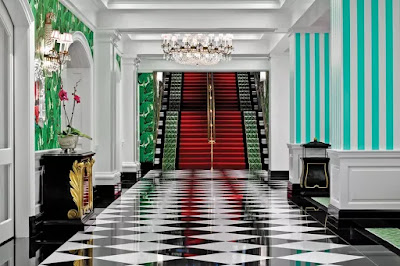WEEK 9 - The Rise of the Decorator / Women in Interior Design
During the turn of the century (early 1900's), there were Interior Decorators, and Interior Designing began to develop as a secondary profession, other than architecture, in the design of an interior space. Before this, it was the architect who would hire different craftsmen to complete the different parts of the interior. But now an Interior Decorator was in charge of fully furnishing an interior, including getting the furniture, art, floor covering, etc.
"The Rise of the Decorator" is a phrase that Interior historian John Pile used to refer to the phenomenon of the growing need for professionals to help with outfitting the interiors of the houses of the wealthy class so that it reflected their status. What influenced this was the post World War I political and economical culture. More upper middle class people wanted help with their interiors because they were dissatisfied with the Victorian style. There was also a need for office spaces to be professionally designed. The increase in media and publication made this phenomenon spread faster. I think this is interesting how medida played a huge role because today social media such as Pinterest is really influential in spreading interior design ideas. I personally have an interior design board (Interior Arts and Architecture), and I also love collecting magazines on Interior Design.
This time in history was also a time where many women entered the profession of Interior Design. Of the three famous pioneers of the profession, two are women--Elsie de Wolfe and Dorothy Draper. (Billy Baldwin being the third). Today women dominate in the profession, with 69%. However, women are still faced with complex prejudices.
Historical Examples:
 |
| Signature black and white floor at the Greenbrier Hotel by Dorothy Draper |
 |
| The Blue Salon of La Fiorentina by Billy Baldwin |
 |
| Sitting room in Marlene Dietrich's house by Elsie de Wolfe |
Current Applications:
 |
| Designed by Margaret Bosbyshell for homeowners who are a huge fan of Dorothy Draper |
 |
| Bedroom with Billy Baldwin-inspired "X benches" |
One Step Further...
Elsie de Wolfe is well known as the pioneer professional interior decorator; best known for her innotive and anti-Victorian interiors. She was born in New York, in 1865, and was educated privately in New York and Edinburgh. She started her career as an actress. However, after redecorating her home, she focused on interior decoration and eventually opened her own company in 1901.
The project that officially started her career was the design of the interior of the Colony Club in New York. She obtained the project through the help of architect Stanford White. She had connections with wealthy people on both sides of the Atlantic, which helped boost her career.
De Wolfe helped interior design become a separate entity from the architectural profession because Interior Decorators did the work that most architects were not interested in or capable of doing. Stanford White's support suggests that he saw her as a valued consultant.
 |
| Trellised room in The Colony Club by Elsie de Wolfe |


Eunice,
ReplyDeleteNice overall summary on the rise of the decorator. We would not be where we are today without it. I like how you connected media today to the media then. As a design industry, Pinterest is huge for ideas and inspiration. Technology like this helps our industry to rise up and gain credibility. I appreciated that you elaborated on Elsie de Wolfe a little more because of her influence on the industry as a whole.